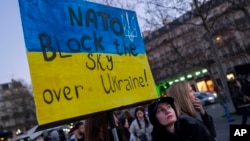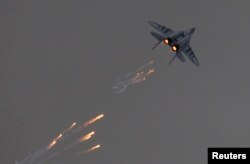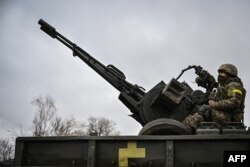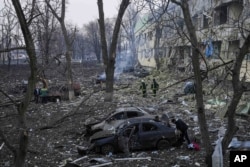U.S. Vice President Kamala Harris travels to Poland’s capital, Warsaw, Wednesday as the Biden administration and its NATO allies debated the best ways to fortify Ukraine while avoiding being drawn directly into the fighting, which would risk a wider European war.
U.S. officials say Harris will be carrying a message to Poland that the United States stands “firmly and resolutely” with NATO allies and will continue to provide aid to Ukraine.
Her visit, however, coincides with diplomatic turbulence over a Polish offer, which caught Washington by surprise, to donate its Soviet-era MiG-29 warplanes to the U.S. for the fighter jets to be transferred to Ukraine. In turn, Warsaw wants Washington to replenish its air force with American-made planes.
The Polish government didn’t get the green light from the Biden administration before going public with the plan, and the Pentagon Tuesday rejected the idea as not “a tenable one.” Victoria Nuland, the third most senior U.S. State Department official, only learned the scheme had been made public by the Poles as she was giving testimony before a Capitol Hill committee and was questioned about it by senators.
Polish officials say they were only taking up a suggestion made by the Biden administration. On Sunday, U.S. Secretary of State Antony Blinken said Washington was considering providing planes to Poland, if Warsaw decided to donate the MiG-29s.
And they emphasize no final decision has been made, saying the final responsibility for the move would need the backing of the entire NATO alliance. In his statement Tuesday about the scheme, Poland’s foreign minister said the Polish government is “ready to deploy — immediately and free of charge — all their MIG-29 jets to the Ramstein Air Base and place them at the disposal of the government of the United States of America.”
They say international press coverage suggesting the U.S. dismissal of the plan is an indication of a fracture in NATO’s common front against Russia is an overstatement.
“There might have been some miscommunication between us and Washington,” a senior Polish official told VOA on the condition of anonymity. “But all alliance partners are trying to plot a way forward to assist Ukraine while at the same time reducing the risk of a wider war. The transfer of the planes would have to be part of a NATO initiative.”
Earlier, Polish Prime Minister Mateusz Morawiecki said a decision about providing to Ukraine 28 MiG-29s, planes which are familiar to Ukrainian pilots, needed to be a joint decision made by all NATO members. “We did not agree to supply planes by ourselves because it must be the decision of the whole of NATO,” he said during a press conference in Warsaw.
News about a possible transfer of MiG-29s had been greeted in Kyiv with jubilation. Ukraine’s President Volodymyr Zelenskyy and his aides have lobbied NATO for additional jets to help it battle Russia in the skies over Ukraine. They have also been urging NATO to declare a no-fly zone over Ukraine to protect the country from Russian airstrikes.
Zelenskyy, who has accused the West of failing to fulfill “promises,” said Wednesday the international community would be responsible for a mass “humanitarian catastrophe” if it did not impose a no-fly zone to protect his country. “When will there be a decision? Look, we're at war!” Zelenskyy said in a video posted on his Telegram channel. “We ask you again to decide as soon as possible. Send us planes.”
But the U.S. is not the only NATO partner wary of being sucked into the war. A senior U.K. minister, Grant Shapps, told British broadcasters Wednesday NATO allies must be sure they are “not inadvertently doing something which escalates this war” with their actions in Ukraine and risk sparking a wider European conflict. All NATO partners “work together” in their efforts to help Ukraine defend itself but as part of “a defensive organization.”
While some NATO partners are more bullish, like the Poles, others, including Italy, fear a transfer of warplanes or an imposition of a no-fly zone would be viewed by Moscow as a casus belli (provocation of war). Russian President Vladimir Putin said Sunday that any move by the West to impose a no-fly zone over Ukraine would be akin to “participating in the armed conflict” against Moscow.
The Russian leader has previously threatened NATO with consequences if it involves itself in the war and has put his nuclear forces on standby.
Nonetheless, as Russian forces bombard Ukrainian towns and shell-fleeing civilians, political pressure is mounting on Western leaders to consider imposing the no-fly zone, prohibiting Russian planes from flying over Ukraine.
U.S. President Joe Biden and NATO officials say there would be logistical problems, especially with moving in sufficient anti-missile batteries to intercept Russian missiles and air defense systems to protect patrolling NATO warplanes. And there would be a high likelihood of coming into direct conflict with the Russian military.
Still, some former NATO generals have broken with the current consensus against imposing a no-fly zone. Retired British General Chris Deverell said this week NATO faces a stark choice between fighting Putin now or facing war later. Deverell told British reporters he had changed his mind about a no-fly zone over Ukraine.
Deverell, who was in charge of military intelligence, cyber and special forces and retired in 2019, said, “I have been against the imposition of a no-fly zone by NATO in Ukraine, believing that it would surely escalate the conflict. But Putin seems hell-bent on escalation. So, the question is becoming: does NATO fight him now or fight him later?”
And a former U.S. NATO supreme commander in Europe is also calling for a no-fly zone. General Philip Breedlove said the move could be carried out without the “bellicose rules of engagement” that could spark a wider conflict with Russia. “How many casualties does it take before we take a different approach to this war?” he asked.
More than two dozen U.S. foreign policy experts, several former diplomats and White House advisers, have issued an open letter to President Biden urging that a “limited” no-fly zone be established over Ukraine to deter Russia’s aerial attacks. Notable co-signers include Kurt Volker, a former U.S. ambassador to NATO during the Obama administration and George W. Bush-era ambassador to Ukraine John Herbst.
Some current serving generals disagree. Admiral Tony Radakin, Britain’s chief of the defense staff, said this week a no-fly zone wouldn’t help as most of the destruction and civilian deaths are being caused by artillery bombardments. “It’s not coming from Russian aircraft,” he argued.
“NATO has been very careful to keep itself out of a direct conflict with Russia,” former U.K. representative to NATO Nicholas Williams said this week. He said in London that NATO is focused on bolstering the defenses of its members. “And so, I don't think NATO will change its view."
But, he says, as in the Balkan wars of the 1990s, public pressure and outrage may well force NATO to act.











